在这篇文章中,我们将看到在 Pandas Dataframe 中将浮点数转换为字符串的不同方法? Pandas Dataframe 提供了更改列值数据类型的自由。我们可以将它们从 Integers 更改为 Float 类型,Integer 更改为 String,String 更改为 Integer,Float 更改为 String 等。
将浮点数转换为字符串的三种方法:
方法一:使用DataFrame.astype()。
用法:
DataFrame.astype(dtype, copy=True, errors=’raise’, **kwargs)
这用于将 pandas 对象转换为指定的 dtype。此函数还提供将任何合适的现有列转换为分类类型的函数。
范例1:将一列从浮点数转换为字符串。
Python3
# Import pandas library
import pandas as pd
# initialize list of lists
data = [['Harvey', 10, 45.25], ['Carson', 15, 54.85],
['juli', 14, 87.21], ['Ricky', 20, 45.23],
['Gregory', 21, 77.25], ['Jessie', 16, 95.21]]
# Create the pandas DataFrame
df = pd.DataFrame(data, columns = ['Name', 'Age', 'Marks'],
index = ['a', 'b', 'c', 'd', 'e', 'f'])
# lets find out the data type
# of 'Marks' column
print (df.dtypes)输出:

现在,我们将“Marks”列的数据类型从 ‘float64’ 更改为 ‘object’。
Python3
# Now we will convert it from
# 'float' to 'String' type.
df['Marks'] = df['Marks'].astype(str)
print()
# lets find out the data
# type after changing
print(df.dtypes)
# print dataframe.
df 输出:
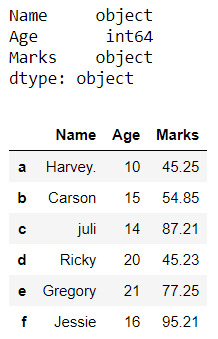
范例2:将多于一列从浮点数转换为字符串。
Python3
# Import pandas library
import pandas as pd
# initialize list of lists
data = [['Harvey.', 10.5, 45.25, 95.2], ['Carson', 15.2, 54.85, 50.8],
['juli', 14.9, 87.21, 60.4], ['Ricky', 20.3, 45.23, 99.5],
['Gregory', 21.1, 77.25, 90.9], ['Jessie', 16.4, 95.21, 10.85]]
# Create the pandas DataFrame
df = pd.DataFrame(data, columns = ['Name', 'Age', 'Marks', 'Accuracy'],
index = ['a', 'b', 'c', 'd', 'e', 'f'])
# lets find out the data type
# of 'Age' and 'Accuracy' columns
print (df.dtypes)输出:
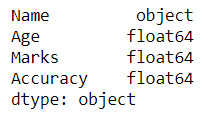
现在,我们将“Accuracy”和“Age”列的数据类型从 ‘float64’ 更改为 ‘object’。
Python3
# Now Pass a dictionary to
# astype() function which contains
# two columns and hence convert them
# from float to string type
df = df.astype({"Age":'str', "Accuracy":'str'})
print()
# lets find out the data
# type after changing
print(df.dtypes)
# print dataframe.
df 输出:
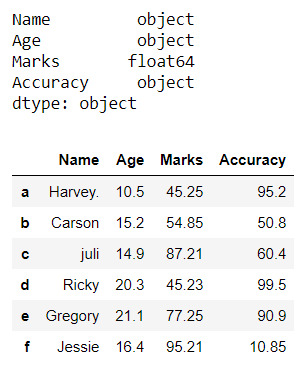
方法二:使用Series.apply()。
用法:
DataFrame.apply(func, axis=0, raw=False, result_type=None, args=(), **kwds)
此方法允许用户传递一个函数并将其应用于 Pandas 系列的每个值。
例:将 DataFrame 的列从浮点数转换为字符串。
Python3
# Import pandas library
import pandas as pd
# initialize list of lists
data = [['Harvey.', 10.5, 45.25, 95.2], ['Carson', 15.2, 54.85, 50.8],
['juli', 14.9, 87.21, 60.4], ['Ricky', 20.3, 45.23, 99.5],
['Gregory', 21.1, 77.25, 90.9], ['Jessie', 16.4, 95.21, 10.85]]
# Create the pandas DataFrame
df = pd.DataFrame(data, columns = ['Name', 'Age', 'Percentage', 'Accuracy'],
index = ['a', 'b', 'c', 'd', 'e', 'f'])
# lets find out the data
# type of 'Percentage' column
print (df.dtypes)输出:
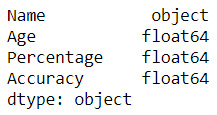
现在,我们将“百分比”列的数据类型从“float64”更改为“对象”。
Python3
# Now we will convert it from
# 'float' to 'string' type.
df['Percentage'] = df['Percentage'].apply(str)
print()
# lets find out the data
# type after changing
print(df.dtypes)
# print dataframe.
df输出:
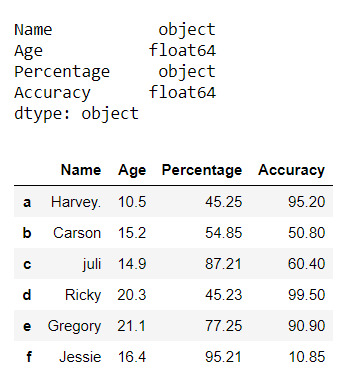
方法3:使用Series.map()。
用法:
Series.map(arg, na_action=None)
此方法用于映射来自具有相同列的两个系列的值。
例:将 DataFrame 的列从浮点数转换为字符串。
Python3
# Import pandas library
import pandas as pd
# initialize list of lists
data = [['Harvey.', 10.5, 45.25, 95.2], ['Carson', 15.2, 54.85, 50.8],
['juli', 14.9, 87.21, 60.4], ['Ricky', 20.3, 45.23, 99.5],
['Gregory', 21.1, 77.25, 90.9], ['Jessie', 16.4, 95.21, 10.85]]
# Create the pandas DataFrame
df = pd.DataFrame(data, columns = ['Name', 'Age', 'Percentage', 'Accuracy'],
index = ['a', 'b', 'c', 'd', 'e', 'f'])
# lets find out the data
# type of 'Age' column
print (df.dtypes)输出:
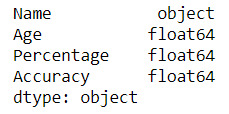
现在,我们将“Age”列的数据类型从“float64”更改为“object”。
Python3
# Now we will convert it from 'float' to 'string' type.
# using DataFrame.map(str) function
df['Age'] = df['Age'].map(str)
print()
# lets find out the data type after changing
print(df.dtypes)
# print dataframe.
df 输出:
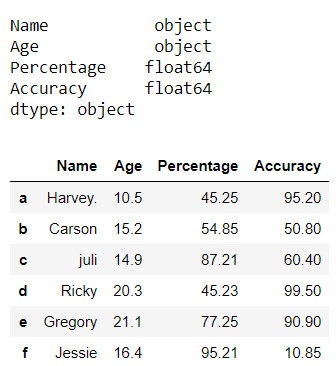
相关用法
- Pandas DataFrame Strings转Floats用法及代码示例
- Pandas DataFrame Integers转Floats用法及代码示例
- Pandas DataFrame Integers转Strings用法及代码示例
- Python Pandas DataFrame.fillna()用法及代码示例
- Pandas DataFrame Integer转Datetime用法及代码示例
- Pandas DataFrame Index转Column用法及代码示例
- Pandas DataFrame String转Integer用法及代码示例
注:本文由纯净天空筛选整理自vanshgaur14866大神的英文原创作品 How to Convert Floats to Strings in Pandas DataFrame?。非经特殊声明,原始代码版权归原作者所有,本译文未经允许或授权,请勿转载或复制。
